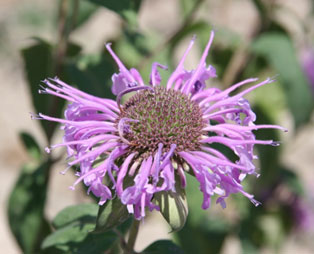Bee Balm in the Landscape

Stephen Love, University of Idaho
Scientfic Name: Monarda fistulosa var. menthaefoliaCommon Name: Bee Balm or Wild Bergamot
Description: Bee balm is an herbaceous, very long-lived perennial. The plants die back to the ground during winter and new shoots emerge from below ground each spring. Bee balm has unbranched, upright shoots up to 30 inches tall. The fragrant leaves are dark green, somewhat triangular in shape, and new leaves are often reddish in color. The leaves often turn red in the fall. The large, flattened flower heads produce numerous pink to violet flowers over a fairly long period of time, June to early August. This species is a good subject for beds and borders among taller forbs and shrubs.
Native Habitat: Bee balm is widespread and native to most Rocky Mountain states and extending eastward into the upper Midwestern states. Found in a range of ecosystems, most commonly in seasonally moist sites. Grows with a diverse group of plants that include species of grasses, forbs, shrubs, and trees.
Cultural Requirement
Soil: Adapted to a range of soils, including those with high pH. Does well in heavier soil with higher moisture-holding capacitie s but can also thrive in well-drained sandy or gravelly substrates.
Moisture Tolerance: This species is not xeric and requires routine supplemental irrigation to remain attractive throughout the season.
Sun/Shade/Preference: Thrives in a range of light exposures from full sun to afternoon or dappled shade.
Transplanting: Easily handles any and all routine nursery management procedures. Transplants well, both from pot to pot and from pot to garden. Plants develop rapidly and do well in pots of any common size.
Propagation: Easy from seed. Requires no stratification or other pretreatment. Can be propagated using crown cuttings or crown division. Plants develop rapidly and occasionally bloom the first year.
Maintenance (pruning, fertilization, deadheading, division, irrigation, etc): Consistent supplemental irrigation is needed (every 8 to 15 days during summer) to keep plants actively growing and attractive. Only occasional, minimal fertilization is needed, as plants demand.
Insect, disease, or other problems: Aphids occasionally become a problem on bee balm, but rarely require control measures. Powdery mildew is pervasive in this species midway through the season and may require some control action.
Landscape Value
Use in the Landscape: Bee balm is an upright, moderately tall plant. It has the ability to grow and bloom in dense plantings. This makes it valuable in beds and borders with a mix of plant species with diverse sizes and shapes. It livens up beds and borders. It is a great plant for filling in around shrubs and trees. It can be effectively used in formal designs but can be incorporated almost anywhere, if sufficient moisture is provided.
Foliage: New growth has a beautiful red tint. Unbranched stems grow vertically from the below-ground crown. The stems are densely covered with moderately large, dark green, glossy, triangular leaves. The foliage is sufficiently attractive to make the plant attractive when not in bloom.
Flower: The flowers grow at the ends of the leafy stems. They are arranged in a large, flat, flowering head. The numerous flowers come in white, pink, or shades of purple.
Timing: June - Aug
Color: White, pink or purple.
Fruit: Senescence of the flowers leaves a spherical fruiting structure made up of many nutlets. Each fruiting head produces numerous seeds.
Form: Upright, shrub-like.
Texture: Moderately course.
Ultimate Size: Plants are 24 to 30 inches tall; similar in width. The plants produce very short rhizomes that cause the plants to very slowly expand in width over time.
Rate of Growth: Rapid. The plants only occasionally bloom the first year, but the foliage grows rapidly and quickly becomes attractive.
Suggested Plant Partners: Bee balm grows well with many native shrubs with moderate water requirements, including Philadelphus lewisii, Cornus sericea, and Rhus glabra. Other good partners include moderates sized clump grasses such as Sporobolus airoides, Deschampsia caespitosa, or Schizachyrium scoparium and wildflowers such as Penstemon venustus, Penstemon rydbergii, Aquilegia coerulea, Aquilegia flavescens, Delphinium geranifolium, and Erigeron glaucus.
Availability: Easy to find as a potted plant at local or mail order native plant nurseries. Occasionally available at traditional nurseries. Seed can be purchased native plant seed suppliers.
Cultivars: 'Petite Delight' and 'Summer's Spice'.
References:
Busco, J. and Morin, N.R. 2003. Native Plants for High Elevation Western Gardens. Fulcrum Publishing, Golden, Colorado.
Love, S.L., Noble, K., Robbins, J.A., Wilson, B. and McCammon, T. 2009. Landscaping with Native Plants. University of Idaho Bulletin #862.
Robson, K.A., Richter, A. and Filbert, M. 2008. Encyclopedia of Northwest Native Plants for Gardens and Landscapes. Timber Press, Portland, Oregon.

